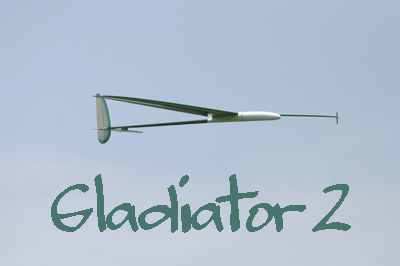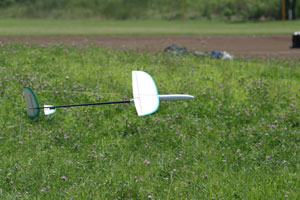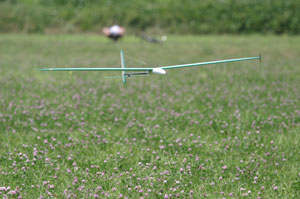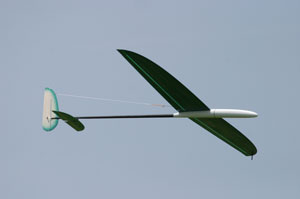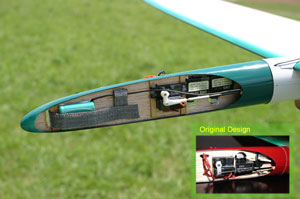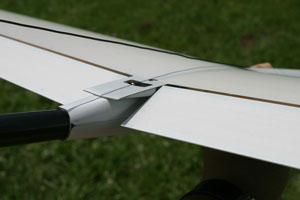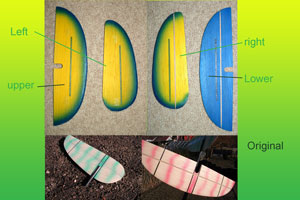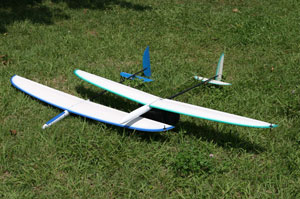| Gladiator II |
|
|
| |
|
Gladiator I |
Gladiator II |
| Wing Span |
1470 mm |
1490 mm |
| Wing section |
MH32 |
HN487 |
| Wing Area |
21 dm2 |
21.5dm2
|
| Wing Load |
16.9g/dm2 |
15.3g/dm2 |
| Structure |
Glass/balsa/glass |
Glass/balsa/glass |
| Portability |
1 piece wing |
1
piece wing |
| |
| Tail
plane |
Tail type |
flat |
flat |
| Tail Area |
2.0dm2 |
2.1dm2 |
| |
| etc. |
Total Weight |
355g |
330g
|
| Empty Weight |
200-230g |
195-200g |
| Radio gear |
4 servos |
4 servos |
Fuselage Length
|
1077mm |
1115 mm |
|
Gladiator II
|
Gladiator1 |
Gladiator2 |
A Gladiator means a slave who fought to the death in the Colosseum of the ancient Roman Empire. A movie with title, "Gladiator" is very familiar. The Gladiator II, DLG is completely different from a muscular fighting man, but a beautiful molded model like the Venus. Gladiator is made by Jaroslav Cermak in Czech Republic. Gladiator II is a second generation of the original Gladiator. Gladiator II is completely different model from the first generation. Its chief characteristics is its airfoil section, HN487, as well as its structure and linkage system. Mr. Cermak, the designer seems to be a perfectionist with a good meaning. Gladiator II has been well-designed, so that the nose ballast requires almost no ballast. In case of the Gladiator II in this page, only 5g ballast is loaded in the nose end. In addition, the total weight was successfully decreased about 20-30 grams. It was finished to be a model with high quality in-depth
|
 |

airfoil section
|
HN series of the airfoil section is developed by Dr. Nobert Habe. He is one of famous theorist in the aerodynamics. His wing is preferred by especially the Germany and Austria. The HN airfoil section is quite good in both the penetration and thermal duration. The airfoil sections by Nobert Habe are used by Sting, New Sting, CARISMA, NYX, NYX-FURIO, NYX-F3F. The high performance has been already proven by those models.
It is a well-known fact for the fliers of Scale models that the homothetic scale-downed model doe not always fly well, even if the original model flies so well. However, I did not seem to be only a flier who wish to fly the 1.5m DLG with HN airfoil, because Mr. Cermak made Gladiator II. The technology that enable the penetration to be compatible with thermal duration is for the technology for the high class model such as F3B, F3J. Those two incompatible characteristics have been masterly implemented into Gladiator II.
|
|
 |
|
Designer
/Manufacturer
|
|
|
Price/Reseller
|
|
|

|
| Gladiator II ギャラリー |
|
|
|
Side view. Cool!! Isn't it.
Gladiator I has a divided aileron, Gladiator II has a single full span aileron.
|
Gladiator I was the double dihedral, Gladiator II is single dihedral.
|
High quality. It's such a beautiful model that the surface finishing may be the same as that of open class.
|
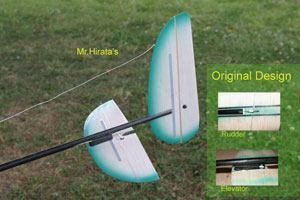 |
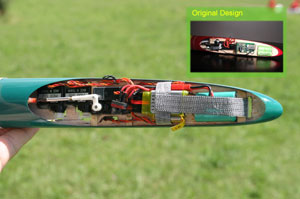 |
|
The wire linkage system is used In the original design of Gladiator II. However Mr. Hirata used the piano string with 0.6mm in the Gladiator II as above picture, because wire linkage sometimes loose its tension. ( The external antenna is used only because some JETI micro receiver was interfered in case of carbon fuselage (boom). It is not always needed to be spanned out side carbon fuselage.)
|
The vertical radio gear mounting adopted by the Starloght2000, Royal-flush, Elita. The location of servos are different from the original design, because of the piano string linkage.
|
Back side of the servo mount plate. Since receiver is installed on the other side, this side is comparatively neat. |
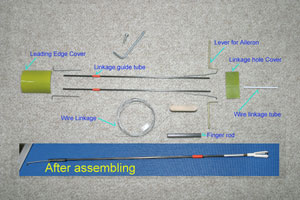 |
 |
|
| The above linkage parts are included in the standard kit. The control linkage for aileron is assembled as shown in above picture.The red short pipe is adhered on the inner side of fuselage pod, and support the movement of this linkage rod. |
The lever for flapperon should be bent and fixed on the spar of flapperon as shown above. then the lever will not slip in the direction of rotation. The central hole of the main plane for combining the lever and linkage rod as shown below. The cover of this hole is attached.
|
The flapperon is under hinged. Therefore the airbrake can be effective, which is useful for landing fixed point precisely. |
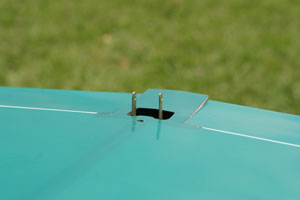 |
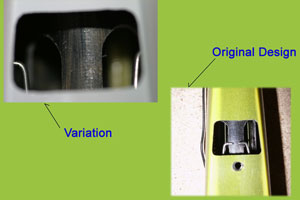 |
|
| flapperon is controlled by this lever.
|
The rod end is vented outward by Mr. Hirata, which was bent inward in the original design. However a reading glass and a tweezers to conjunct this linkage and the lever.
|
The tail plane is beautifully painted, but with no film in the original design. It may be for reducing weight.
|
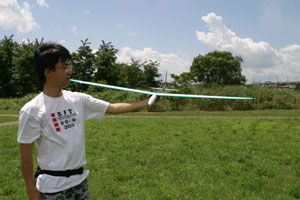 |
 |
|
Mr. Tsumori, who participate in the Japanese Human-powered flying machine, has this new model at the first time. Because of it, He would become a pilot of Gladiator II..
|
This is the man who assembled Gladiator II shown in this page. He is a man of craftsmanship. His hand is sure.
|
Gladiator I and II. Gladiator I is bigger than Gladiator I one time. The nose of Gladiator II is longer than that of Gladiator I. As a result. It is amazing that almost no nose ballast is required. In addition, the total weight is decreased about 20-30 gram compared with Gladiator I. |
Mr. Hirata's comments
Mr. Hirata gave me some comments, who assembled Gladiator II introduced by above pictures. This might be the first time for him to assemble such a type of linkage as used by the Gladiator II. He seemed to have much fun like solving a Puzzle. He tried to make Gladiator II based on the design by Mr. Cermak as far as he can. However he adopted conventional piano string linkage based on his many experiences. The original wire linkage uses steel string, so there is few weight increase, even if the piano string is used.
|
 |
| Wing: |
It looks like that Mr. Jaroslav Cermak uses F3J/F3B model technology, because Lubos Pazderka(manufacturer of Eraser) seems to be a good influence on him. It is not coincidental that the URL of the web site of Mr. Cermak(www.f3k.cz) is similar to that of Mr. Lubos Pazderka (www.f3j.cz). If Gladiator II is the model for slope, this approach is quite natural. My point is that Gladiator II is the DLG that must be light enough. The main plane is molded using the 3 layered structure with glass/balsa/glass sandwich that is familiar in the F3J/F3B model. Using shell-structure, The inside of the main plane is empty but stiffer and light, compared with the main plane made of the foam with Balsa plank in the past, even if the surface is flexible. The surface of Gladiator II is not harder than Radina DLG that use similar technology. However the main plane as a whole is to be stiff by a spar and strategically placed carbon reinforcement on it.
By comparison of the plans of Gladiator I and II, you know that Gladiator II has double dihedral at the center and quarter of the main plane, Gladiator II has a single dihedral. If you hold the main plane with section HN profile, the Gladiator II (HN487) is obviously thinner than Gladiator I (MH32). The high performance of airfoil of HN has been already proven by the NYXs and New Sting and so on. A thin airfoil is, theoretically speaking, good for the fliers from the view point of penetration and thermal duration, it is not good for the manufacturer to make a thin main plane without torsions and to make a thin plane be stiff. Some high technologies must be required. Gladiator II has successfully realized it .
As for the aileron linkage, such a technology is adopted that is used by the FIREWORKS3 developed by PCM in Germany. The aileron servos should be installed in the fuselage in order to concentrate the mass and reduce the rotational momentum. Therefore it is the problem This technology is familiar in the area of the V-tail linkage for the open class airplane. It must be a challenge to use such linkage for DLG/HLG. It is clearly easy to establish a linkage with aileron outside fuselage. It is very elegant to accommodate the aileron linkage into the fuselage, but honestly speaking, it is not welcomed for old fliers that the reading glass and tweezers are required to conjunct aileron linkage and the aileron lever.
|
 |
| Fuselage: |
The fuselage of Gladiator was changed from with the canopy to nosecone. The vertical radio gear mount enables us be easier to accommodate receiver and servos in to the fuselage as shown in the above pictures. The nose length of Gladiator II became to be longer than that of Gladiator I. As for the center of Gravity, it is well-designed so that the gravity center locates as designed with almost no ballast just after installing the receiver, servo and buttery. The span of wing became 20mm longer and the length of fuselage became 38mm longer than Gladiator I respectively. On the contrary, It is excellent that the total weight was reduced about 20-30 grams. Because the fuselage (boom portion) diameter is large enough, Radina DLG is so strong enough that we can fly Radina DLG without feeling any anxiety. Gladitor I has very skinny fuselage, some fliers broke fuselage when it was launched with his full-power. It is chief reason that the strength of carbon pipe in the fuselage is not enough as well as the structure of pod of the fuselage. Here is a comparison about the diameter of the carbon fuselage pipe at their root.
|
Model |
Diameter |
| Radina DLG |
17.5mm |
| Gladiator I |
12.5mm |
| Gladiator II |
15.8mm |
|
The fuselage pipe of Gladiator II became strong enough to swing with full power. The fuselage length of Gladiator II is 117.5cm, the longest in those three models, which is about 4 cm longer than Gladiator I. The fuselage length of Gladiator II in the picture is 117.5cm, which is 6cm longer than its design so that the center of Gravity locates as specified by its design. But the nose ballast was only 5 grams.
The JETI Rex 5 Plus(FM PPM 5 channel) receiver is used. It is light and small enough. But it is sometimes interfered by the electro-magnetic environment. So the antenna was spanned outside fuselage. In usual, this is not required. (The transmitter is Futaba FF9 which can transmit signal 6th channel output signal through 5th channel. Therefore 6 channel is not required by the receiver.) As for the servo, GWS PICO STD (Torque:0.8kg, Speed:0.10 sec/10deg. Weight:6g) is used. Since GWS servo is not always reliable, but it is cheep, which is acceptable enough for DLG. Total weight is 330g. However I have an impression that Gladiator II become greatly lighter than Gladiator I.
The tail plane is simple balsa plank with Carbon roving reinforcement, but without Oracover light. It maybe enough, but Mr. Hirata cover the tail plane by thin film. (This is a matter of the individual)
|
 |
| Flight: |
Gladiator II reaches to higher altitude than Gladiator I. It is about 35-40m at least. The long fuselage makes its flight be stable. Mr. Kanoh, who is famous as a missionary of Radina DLG in Japan, recorded the flight of his Gladiator II by LOLO2, which shows 45m. If airborne condition is good, 50 m will be possible. The response to the thermal by Gladiator II is quite well so that we can find thermals easily. When Gladiator II meets the thermal, it does not respond too much to it, therefore we can control Gladiator II easily and enter into the thermal riding on the thermal.
The comprehensive flight impression that Gladiator II is one rank higher than Gladiator I and the conventional DLG such as Radina DLG. (Radina DLG became a standard in Japan.)
|
 |
| Technical Notes: |
Here is the standard trim setting and the trim by Mr. Hirata.
The trim by Mr. Hirata is gentle, it can be wilder according to favorites of the individual.
|
 |
|
